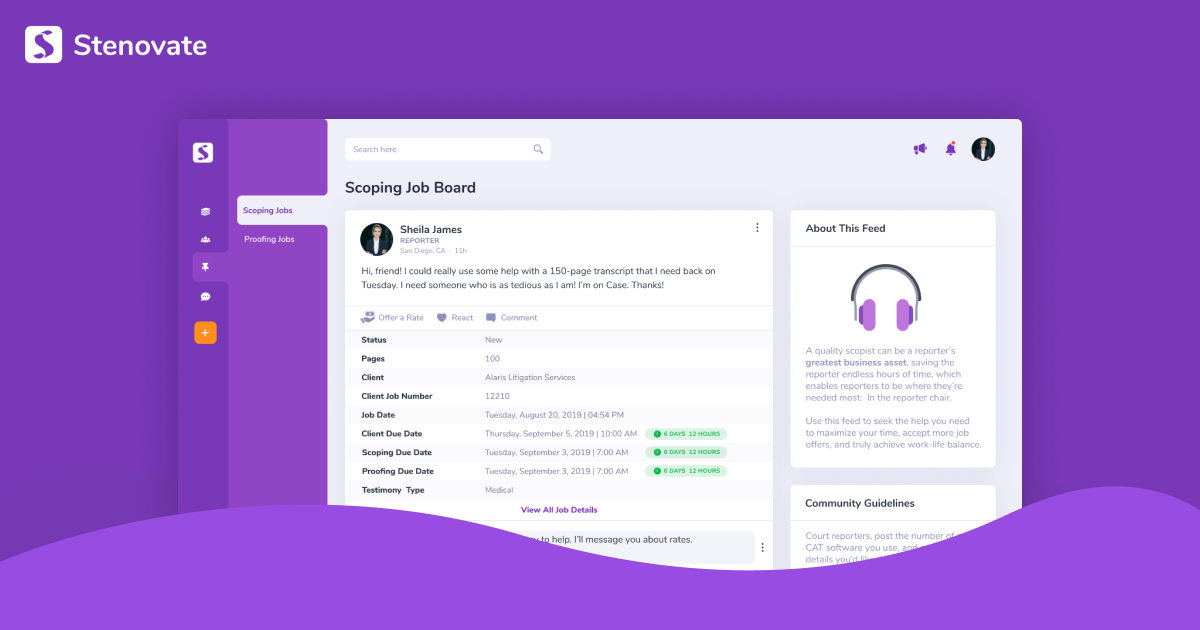The next time you pull an all-nighter to finish a surprise expedite, you’re going to wish you had a transcript team
What’s a transcript team? It’s you (the court reporter) and your go-to scopist and proofreader. These teammates are invaluable — and they can help you double your profit per hour.
Don’t wait to start building these important relationships until you’re working against an important deadline. Now is the perfect time to find, vet, and hire your transcript dream team. Here’s how:
Finding Potential Teammates
There are plenty of great places to find help today. If you believe you can’t find a “good” scopist and proofreader, you haven’t looked hard enough! #TheyDoExist
Over the years, I’ve found my transcript teammates through a variety of channels. Here are my Top 5 favorites in reverse order:
Number 5: Facebook Groups
Facebook groups are the most popular source of scoping and proofreading help today. Lots of people are on Facebook, which makes it a viable option for finding the help you need.
The challenge is finding the right help in a flood of job inquiries.
Some Facebook groups are better than others for finding scopists and proofreaders. Here are my favorites:
- Triple Threat Scoping Job Board
- Scopists & Proofreaders – NCRA
- Court Reporters & Scopists Connect
Still, it can take a while to find help on Facebook. This is one reason why we created Stenovate: Finding professional scopists and proofreaders… FAST.
The reason that Facebook is our least favorite place to find help? Even though it’s popular, it feels the least professional because it’s also where people vent, post photos of their puppy, and play games. Personally, I prefer to get into a mental “work zone” when I’m seeking help and collaborating. Which leads us to…
Number 4: LinkedIn
Another great social network is LinkedIn. It has many of the same upsides as Facebook but without the personal clutter. Plus, LinkedIn gives you more professional data, allowing you to see someone’s job history and educational background.
To find transcript teammates on LinkedIn, simply search for the terms “scopist” or “proofreader.” You can filter your search for better results.
My favorite is to use the “Connections” filter and search for 1st or 2nd connections only. This means that I’m only looking at people with whom I’m directly connected on LinkedIn, or someone I know is connected to them. This makes it easier to ask for a recommendation or referral to your connections.
Number 3: Agency Recommendations
If you have agencies asking you to take work, and you’re responding, “I can’t, I have to catch up on my page backlog,” the agency has a big incentive to help you find a scopist and/or proofreader. So ask!
Many agencies are happy to help you find trusted scopists and proofreaders. They may even circulate an email on your behalf to their contacts to make connections. After all, your success is their success!
Number 2: Personal Recommendations from other Reporters (Referrals)
Referrals are the best source for great teammates because they come with a personal recommendation.
Think about a colleague you trust — one who has built a transcript team and does a high volume of pages. Reach out and ask if they can recommend a scopist or proofreader. Most reporters are very willing to help; however, if you DO come across reporters who refuse to give up their secret weapons (it happens!), have no fear. There are plenty of other sources of great teammates.
Number 1: Stenovate
Stenovate has active job boards for both scopists and proofreaders.
But unlike Facebook groups or LinkedIn, Stenovate is just for transcript professionals. Plus, it’s the #1 project management tool for transcript teams.
Once you find your stellar transcript teammates on Stenovate, you don’t have to coordinate processes, like how you will communicate or transfer files. Once you add a job to Stenovate, you can add add your new teammate to the job which will give them access to everything you need to collaborate efficiently.
Plus, sharing job details is a breeze and can dramatically reduce excessive communication time.

We built Stenovate to make it easier to find and work with your transcript teammates. As a super busy reporter, I searched and searched for a tool like this so I could spend as much time as possible in the reporter chair. When I couldn’t find what I was looking for, I started wondering if I was the only one searching for a tool to help me and my team complete more pages with less hassle. It turns out, I wasn’t alone!
The Stenovate community is growing. Why not try it free for 30 days to see what a world of difference it can make?
Vetting and Hiring
Now that you know where to look for teammates, let’s talk about vetting and hiring.
Having a thorough vetting process is key to making good hires. There are three key steps:
- Resume
- Interview
- Audition
Resume
Experience and education are obviously important considerations when hiring. We all know that finding a former court reporter is gold! But there are lots of other backgrounds that can make for great help.
For example, my high school English teacher is my main proofreader! She’s a total gem and is very particular. Some paralegals have turned into great scopists. Look for people who have done work that requires attention to detail.
Whatever their background, make sure your scoping candidates are proficient in your transcript software, like CaseCAT or Eclipse. Bonus points if they’ve had actual CAT training. If they list that they help with auto-indexing, there’s another huge perk. If they don’t list things, be sure to ask when you interview them!
Interview
Interviews can be daunting. Take the pressure off by treating it as a friendly conversation. Talk about the candidate’s past work experience, their values, and their work habits.
Demeanor is an underrated attribute in hiring. Will you and the candidate get along well? You’ll be spending a lot of time with this person — make sure you mesh.
When it comes to hiring, I like to use the mantra, “Trust but verify.” Ask for job references and follow up with the candidate’s past employers. You’ll learn a lot from these conversations.
Audition
If a candidate makes it through the resume and interview, the final step is “The Audition.”
This is a term coined by Mike Hensley, Vice President of the California Court Reporters Association.

The Audition is a test transcript. Its purpose is to see the candidate in action and see the quality of their work.
You have a few options:
- Build a “test template”
- Use a short test of an unscoped / unproofed transcript and then review.
Build a Test Template
Most, if not all reporters, are very familiar with their own common errors. I’ve created a scoping test template using 15 pages of a past transcript, and I made sure to add all the things I frequently goof up in my writing.
For example, if you know your drag your -L on a certain word that gives you another similar word, use that as a “known error” to ensure that the scopist or proofreader catches the error. You can even print the pages off and mark the spots you need to check to make sure they found and fixed everything you expected.
Add as many “known errors” as you’d like and use this template over and over for vetting scopists.
Send a Short Test Sample
If you just can’t get your head around spending the time to create a 15-page test template, you can always send a small sample of work for them to complete.
It’s important to send them a small section first to see how they do before bombarding them with 300 pages. If you give them too much to do before you know you’re happy with the end result, it can turn into an uncomfortable situation five days later when you review their work quality. At this point, you’re trying to meet a quickly-approaching deadline, and if you’re not happy, you may need to redo the work.
This scenario can be very easily avoided by giving a short sample on a short turnaround to ensure that you’re pleased with their work and they can meet a simple deadline. From there, I recommend giving larger sections and building up to larger pieces of work as you continue to review and build trust.
This is also the perfect way to continue the conversation about preferences and expectations as they begin to handle more work for you.
Some scopists or proofreaders will offer the first 10-15 pages for free as a hook to get you to try them out. If they don’t offer this, you can ask, but I recommend paying them for their time. And if you send them small sections and build up, you won’t be out much at all if it doesn’t work out.
Trust me, it’s worth the price AND the time to get a great teammate! A small investment for a massive return.
Whether you create a test template or send a small unscoped section, keep these tips in mind for their audition:
- Share your preferences. Sometimes a scopist or proofreader isn’t “wrong,” they just don’t know your preferences. Share your preference sheet with the candidate so they know what you’re looking for. You can create a custom preference sheet with Stenovate’s FREE Ultimate Preference Sheet tool.
- Test for your common mistakes or writing quirks. Make sure the test transcript has all the mistakes you commonly make, like dragging the -L, strange stacking, or misspelled words.
- Also pay attention to intangibles. Did the candidate deliver the transcript on time? Are their communication skills up to par? Did you enjoy working together?
After a thorough vetting process, you can feel confident that you’ve begun building a partnership that will save you endless hours being hunched in front of your computer. What on earth will you do with all your new-found free time?
Up Next: Building Winning Relationships with Your Teammates
Congratulations! Now you know how to find, vet, and hire great transcript teammates.
But this is just the beginning of a new and wonderful business relationship! Even the best scopist or proofreader may struggle without basic leadership from you. (Don’t worry. It’s easier than you think!)
In the next article of this series, we’ll show you how to set expectations, build a winning process, and keep your teammates happy and motivated.
In the meantime, start your search for new transcript teammates. Your future self will thank you!
Get 50% off your first 3 months of Stenovate. Just use the code DELEGATE50 when you sign up.


